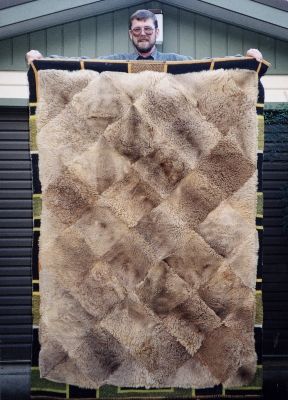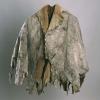Quilt No.586CW - Colin Wilkinson

The kangaroos were shot by Colin Wilkinson's father in 1965 and the skins tanned and the rug made by Syd Bayliss at his saddlery shop 'Valley of the Whites Trading Post'* in Tumut 1965. It has always belonged to the present owner, Colin Wilkinson. It is still used occasionally on very cold nights, in addition to a doona.
"Skins for my fur rug were obtained during licensed culling, by shooting, of kangaroos on my family's property 'Hillview' Yellowin, at the top end of Blowering valley. The kangaroos were shot by my father during a number of winter nights in 1965. At that time I was a skinny 13 year old boy and it was my job to locate, and hold the spotlight of the beam on, the unfortunate animal while the 'deed' was done. As the night progressed, with a frost beginning to form on the cold paddocks and mist rising from the creek, my young fingers became ever more rigid as I clung resolutely to the spotlight's grip. It was then that I would wrap my hands around the hot metal body of the spotlight and hold its warming beam next to my face, only to be jolted quickly back to the job in hand with a curt 'Keep that damn light still' from my father.
So it was that around 20 to 25 of our best 'roo skins were eventually taken into Tumut for Syd Bayliss* to tan and make up into my wonderfully warm fur rug. For many years its heavy bulk has kept me cosy in bed, and every one of those nights, as I drew the covers up around my ears, I would remember those freezing cold nights out in the paddocks."
Colin Wilkinson 18.5.00]
* "One of the first things you notice about Syd Bayliss' saddlery and tannery business is the name , 'Valley of the Whites Trading Post'.
There's a reason for the somewhat unusual name boldly displayed above the business premises, together with two larger-than-life size 3 ply white kangaroos.
Syd Bayliss, a bulky figure with a serene face and a ready smile, adopted the name after an irate Adelong man, claiming he had received the wrong fox skin, burst into his tannery just on 20 years ago. After his anger had cooled somewhat, the man's attention had been drawn to a white kangaroo skin (unknown to him bleached) and he had immediately laid claim to knowledge of the whereabouts of a wild kangaroo with the same colouring.
Mr. Bayliss having taken exception to the complaint, took up the pretence, quickly making the man envious with stories of a secret beautiful valley in the district, containing hundreds of white kangaroos where the limestone deposits had apparently led to even the fish being coloured white.
From then on it was both his favourite tale (amongst hundreds) and his trading name."
[Extract from article by David Watson, Tumut and Adelong Times, June 6, 1972]






